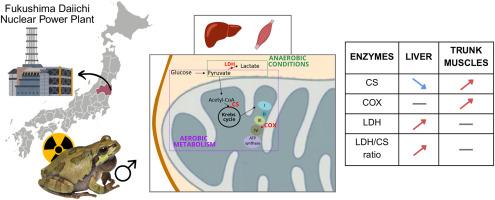环境放射性对福岛树蛙生物能的影响
IF 7.3
2区 环境科学与生态学
Q1 ENVIRONMENTAL SCIENCES
引用次数: 0
摘要
2011年福岛第一核电站事故导致周围环境的放射性核素受到污染,并导致当地野生动物长期暴露在电离辐射下长达十多年。本研究调查了放射性污染对福岛县树蛙(Dryophytes leopardus)的长期影响,重点研究了生物能量学,这是一个控制生存和繁殖的主要过程。在繁殖季节,沿着放射性污染的梯度收集雄性树蛙,并检查它们的能量代谢,特别是在躯干肌肉,主要参与鸣叫和肝脏,一个关键的排毒器官。我们的研究结果表明,躯干肌肉的有氧代谢随着电离辐射剂量率的增加而增加,这与线粒体氧化能力的增加有关。相反,肝组织表现出有氧代谢的减少,通过厌氧过程的上调来补偿,可能是由于三羧酸循环损伤。此外,我们观察到肝体指数和整体身体状况随着电离辐射水平的升高而增加,表明生理变化。这些结果表明,在最初的放射性污染发生十多年后,福岛树蛙的代谢过程和身体状况在放射性污染区内仍然受到调节。这突出表明需要进一步调查受影响野生动物群体长期电离辐射暴露的生态和进化后果。本文章由计算机程序翻译,如有差异,请以英文原文为准。

Environmental radioactivity impacts bioenergetic in tree frog of Fukushima
The Fukushima Daiichi Nuclear Power Plant accident in 2011 resulted in the contamination in radionuclides of the surrounding environment and led to a chronic exposure of local wildlife to ionizing radiation for over a decade. This study investigates the long-term effects of radiocontamination on the tree frogs (Dryophytes leopardus) in Fukushima Prefecture, focusing on bioenergetics, a major process that governs survival and reproduction. Males tree frogs were collected along a gradient of radiocontamination during the breeding season and their energy metabolism was examined, particularly in trunk muscles, heavily involved in calling, and liver, a key organ for detoxification. Our results show that aerobic metabolism in trunk muscles increases with ionizing radiation dose rate, associated with an increase in mitochondrial oxidative capacity. In contrast, liver tissues exhibit a decrease in aerobic metabolism, compensated by an upregulation of anaerobic processes, likely due to tricarboxylic acid cycle impairment. Additionally, we observed an increase in both the hepatosomatic index and overall body condition with rising ionizing radiation levels, indicating physiological changes. These findings suggest that more than ten years after the initial radiocontamination, metabolic processes and physical condition of tree frogs in Fukushima are still modulated in radiocontaminated areas. This highlights the need for further investigations into the ecological and evolutionary consequences of long-term ionizing radiation exposure in affected wildlife populations.
求助全文
通过发布文献求助,成功后即可免费获取论文全文。
去求助
来源期刊

Environmental Pollution
环境科学-环境科学
CiteScore
16.00
自引率
6.70%
发文量
2082
审稿时长
2.9 months
期刊介绍:
Environmental Pollution is an international peer-reviewed journal that publishes high-quality research papers and review articles covering all aspects of environmental pollution and its impacts on ecosystems and human health.
Subject areas include, but are not limited to:
• Sources and occurrences of pollutants that are clearly defined and measured in environmental compartments, food and food-related items, and human bodies;
• Interlinks between contaminant exposure and biological, ecological, and human health effects, including those of climate change;
• Contaminants of emerging concerns (including but not limited to antibiotic resistant microorganisms or genes, microplastics/nanoplastics, electronic wastes, light, and noise) and/or their biological, ecological, or human health effects;
• Laboratory and field studies on the remediation/mitigation of environmental pollution via new techniques and with clear links to biological, ecological, or human health effects;
• Modeling of pollution processes, patterns, or trends that is of clear environmental and/or human health interest;
• New techniques that measure and examine environmental occurrences, transport, behavior, and effects of pollutants within the environment or the laboratory, provided that they can be clearly used to address problems within regional or global environmental compartments.
 求助内容:
求助内容: 应助结果提醒方式:
应助结果提醒方式:


